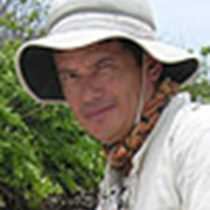Floreana Island
Floreana or Charles Island is one of the oldest islands of the archipelago. It is certainly one of the most beautiful as well. It was visited by buccaneers and pirates during the 16 and 17 hundreds as a place to collect supplies like giant tortoises and fresh water. It was also visited by Charles Darwin in 1835.
Early in the morning we landed at Punta Cormorant on a greenish inorganic beach. Its color comes from high concentrations of olivine, a green mineral commonly found here. Walking along the beach, we observed the geological features of the island. There are many conical formations, ancient volcanoes that became extinct thousands of years ago are found everywhere. Today there was a noise around a brackish lagoon that caught the attention of our guests; it came behind the beach and we walked in that direction to discover a spectacular view: A flock of flamingos feeding along the brackish lagoon, with a gorgeous pink color that contrasted with the green vegetation and the brownish color of the water. Our guests took many pictures of them enjoying their sounds and admiring how quickly they moved their beaks while filtering small and delicious crustaceans, their main diet and reason for their color.
After breakfast we began our second outing in the morning, using our Zodiac fleet to explore Champion Islet. Our mission: Encounter the elusive Floreana mockingbird. This rare bird species became extinct on the main island of Floreana and nowadays is only found on only two satellites islets around of it. Our guests observed many of them fluttering around the cacti trees while on the cliffs, a group of seabirds such as Red-billed Tropicbirds, Swallow-tailed gulls, Brown Noddy Terns and Galápagos Shearwaters caught our attention with their unmistakable voices. After the Zodiac ride we returned to the ship to gear up with our snorkeling equipment for our undersea exploration. We snorkeled along the shore of Champion Islet; the visibility was excellent and the sea was as calm as a swimming pool. The latter were perfect conditions to observe a great variety of tropical fish such as Creole fish, Moorish idols, Parrot fish and White-tipped reef sharks. The best attractions were the Galápagos sea lions, our companions during the whole snorkeling outing.
Our afternoon started with kayaking along Floreana’s coastline near Post Office Bay. We observed the forest of mangroves along the shallows, trees that literally “walk” with their long branches along the shallows, as reclaiming an area that usually is full of water. At the distance we observed white beaches where sea turtles come for nesting, including the famous Post Office Bay’s beach. After kayaking we landed at Post Office Bay where the enigmatic and old barrel still receives letters emulating ancient times during the whaling era along the Pacific Ocean. Our naturalist Walter Perez talked about the barrel and its history, and the reasons why Floreana is by far the island with the richest human history in the archipelago.
It was late when we finally came back to National Geographic Islander. Today was a little different because our guests could enjoy a beautiful sunset that provoked feelings of admiration and gratitude to nature for giving us this beautiful place called Galápagos.




